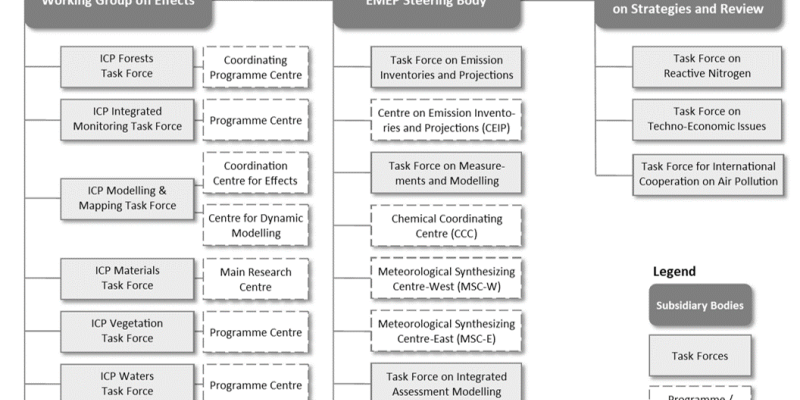Political context
 Click to enlarge
Click to enlargeSource: UNECE
 Umweltbundesamt
Umweltbundesamt
 Click to enlarge
Click to enlargeThe CCE is an organizational entity under the CLRTAP of the United Nations Economic Commission for Europe (UNECE) (see organigram above). The CLRTAP was signed in 1979 and came into force in 1983. It was the first international legally binding instrument to deal with problems of air pollution at a broader scale. The goal of the convention is to control air pollution and its effects and to develop an extensive programme for the monitoring and evaluation of the long-range transport of air pollutants.
To develop the necessary international cooperation in the research on and the monitoring of pollutant effects, the WGE was established under the Convention in 1980 and held its first meeting in 1981. The WGE provides information on the degree and geographic extent of the impacts of major air pollutants (such as sulphur and nitrogen oxides, ozone, volatile organic compounds, persistent organic pollutants, heavy metals, particulate matter, including black carbon, and ammonia on human health and the environment). This work is conducted by its six International Cooperative Programmes (on Forests, Waters, Materials, Vegetation, Integrated Monitoring and Modelling and Mapping) and the Task Force on Health.
The ICP M&M was established in 1988 with the aim to develop and provide strategies for emission reductions as inputs to the negotiations of protocols to the CLRTAP. The programme is operated by the Task Force Modelling and Mapping (TF M&M), which is led by France (located at INERIS - L’Institut National de l’Environnement Industriel et des Risques) and chaired by Alice James Casas.
The ICP M&M particularly fulfils the requirements from Article 7(d) and 8(f) of the Convention. Article 7(d) of the Convention states that research should be conducted into the effects of sulphur compounds, and other major air pollutants, on the environment, including agriculture, forestry, natural vegetation, aquatic ecosystems and materials. Article 7 further emphasizes the development of dose-response relationships designed to protect the environment. Article 8(f) calls for exchanging available physico-chemical and biological data relating to the effects of long-range transboundary air pollution and the extent of the damage that can be attributed to long-range transboundary air pollution.
Here you can find the revised mandate for ICP Modelling and Mapping:
ECE/EB.AIR/144/Add.1 (unece.org) (Decision 2019/20)
In 1990, tasks of the CCE were offered by the Netherlands to the CLRTAP of the UNECE. The CLRTAP adopted the CCE as programme centre of the ICP M&M under the WGE.
The objectives of the CCE are
and to provide the results to the relevant bodies under the CLRTAP, especially for the purpose of policy support through integrated assessment. In order to perform these tasks, the CCE collaborates with a European network of National Focal Centres (NFCs) of the ICP M&M. In this context, the CCE is regularly requested by the Convention to issue calls for data (CfD) to these NFCs. Each country has a National Focal Center (NFC). All NFC essentially follow the mapping manual (Manual on Methodologies and Criteria for Modelling and Mapping Critical Loads and Levels and Air Pollution Effects, Risks and Trends) to produce national critical loads. The NFCs also have the possibility to extend, modify or refine the methods used based on accepted national approaches. These variations are documented and form part of a national report contained in the status reports of the CCE.